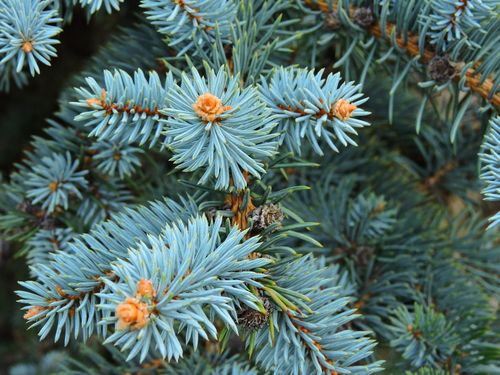
Every year is different when it comes to Christmas. But in my home, there is one thing that remains constant. When I shop for a tree, I always head straight for the Fraser firs. These are the trees I grew up with, and their fragrance reminds me of my childhood. And as we all know, memory is a key component in any holiday décor.
Today, the Fraser fir is one of the most popular types of Christmas trees sold. Blessed with good form and upward-pointing branches, it is uniquely suited for heavy ornaments. But for me, its greatest asset is its smell. An intoxicating blend of pine and lemon, it’s the first thing that greets me at the door, instantly boosting my mood during the Christmas season.
4 KEY THINGS TO REMEMBER WHEN SELECTING A TREE
That being said, there is more than one type of Christmas tree available. In fact, there are now over 35 different species being grown, answering to all kinds of tastes and décor. Regardless of which one you choose, though, there are four key things to consider before making a purchase. They are:
Freshness * Needle Retention * Branch Structure * Durability
HOW DO I TELL IF A TREE IS FRESH?
This is the crucial question. Unless you’ve chopped your tree down in the woods, it can be hard to determine a pre-cut tree’s freshness. To that end, the most important indicator is its needle retention. A fresh tree’s needles are pliable, meaning they stay put, even if you pull on them.

Pull on the needles to see if they’re fresh
Another key indicator is the trunk. According to North Carolina State Extension/Christmas Trees, a fresh tree has a sticky one.

Sticky trunks indicate freshness
Ready to try something new? Following are specifics on five popular Christmas tree types and how they fit the above parameters.
FRASER FIR
Native to the Appalachian Mountains of the southeastern United States, the Fraser Fir is named after the Scottish botanist John Fraser (1750-1811) who discovered it in the late 18th century. Since that time, growing and harvesting Fraser firs for holiday decoration has become a multimillion-dollar business in southern Appalachia, with North Carolina producing the majority.

Fraser Fir
One of the most recognizable characteristics of this Christmas tree type are its needles. Short and soft, they are blue-green on the surface and silver below, giving the tree a shimmering quality. The Fraser fir is naturally pyramidal, has excellent needle retention and stays fresh for weeks while emitting a pleasant, forest scent. Sturdy limbs make it perfect for heavy ornaments. And plenty of open space between branches makes decorating easy.
DOUGLAS FIR
It may contain the word fir, but the Douglas fir is actually a member of the pine family. Native to western North America, it is named after David Douglas, the Scottish botanist who discovered it.

Douglas Fir
The family connection explains the Douglas fir’s soft green needles, a characteristic of most pine species. Radiating in all directions from the twig like a bottle brush, they emit a sweet fragrance when crushed. Douglas firs are nearly perfectly conical and their branches are spreading to drooping, the perfect holiday shape. You can almost imagine them laden with snow.
COLORADO BLUE SPRUCE
Also known simply as blue spruce, this conical tree with short needles and stiff horizontal branches is the most commonly used Christmas tree type in the Midwest. A nice pyramidal shape and strong limbs make it an excellent choice for decorating.

Blue Spruce
Lovely bluish-gray foliage give it an added allure and its needle retention is among the best for spruces. But beware — the needles emit a bad odor when crushed. As the popularity of Colorado blue spruces as landscape ornamentals has grown, many consumers now purchase them as ‘living’ Christmas trees to be planted after the holiday season.
BALSAM FIR
Known for its fragrance and near perfect conical shape, the Balsam fir has the distinction of having been chosen for the first National Christmas Tree on the Ellipse by President Calving Coolidge in 1923. Harvested from Vermont, the 48-foot tall specimen was decorated with 2,500 red, white and green electric bulbs. Since then, the types of National Christmas Trees have varied, with this year’s 30-foot tall blue spruce hailing from the state of Pennsylvania.

Balsam firs are generally found in the northeastern United States and eastern and central Canada. Aside from their distinctive provenance, what makes them so attractive are their short, flat, dark green needles, flexible branches, and slender pyramidal shape (including a spire-like tip perfectly suited for an angel or Christmas star).
SCOTCH PINE
Native to northern Europe and northern Asia from Scotland to Siberia, the Scotch pine today is the most widely planted tree in the United States.

Scotch pine
Also known as Scots pine (in reference to its Scottish roots), its blue-green needles have a distinctive twisted shape, turning 360° as they leave the twig. As an added bonus, the tree rarely sheds its needles.
Scotch pines can be tough on the hands while decorating, however, as needles can be sharp as pins. I recommend wearing gloves when hanging your ornaments.

